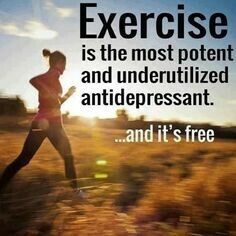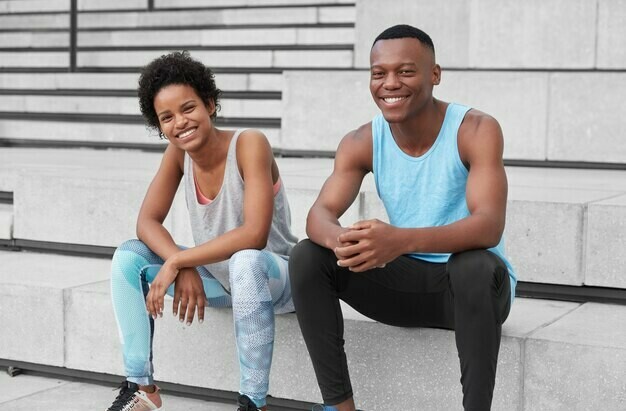THERE ARE MANY BENEFITS
Most of us are aware of the physical value of exercise activity. The benefits are unmistakable and include:
- Improving our skills in sports
- Giving us more attractive bodies
- Protecting against many chronic diseases
- Helping us lose and manage weight
- Lowering our blood pressure and improving heart health
- Improving joint pain and stiffness
- Giving us greater strength and balance
- Increasing our life span
There are also many mental health benefits of exercise, which to some of us may be less obvious. My purpose in writing this post is to examine the many mental health benefits of exercise. Physical activity has a positive impact on our well being and mood, as examples.

The remainder of this post will consider the connection of exercise and mental health in more detail and finish with sources for relevant items and a request for comments.
IMPACT ON OUR WELL-BEING
The Mental Health Foundation generally defines mental health well-being as encompassing:
- A sense of feeling good about ourselves and being able to function individually or in a relationship
- Our ability to cope with challenges and make the most of opportunities
- Our connection to our community and surroundings
- A feeling that we have control of our lives
- Our sense of purpose and of being valued
Mental well-being does not suggest that we are always happy and without negative emotions.
Physical activity has been shown to reduce stress and anxiety. This activity can involve team sports, individual sports (tennis, golf. swimming), occupational activity, walking or household chores. It is important to choose a sport or activity that we enjoy, so that we will be more inclined to continue with it longer.
Our mood is impacted positively. Studies show that active people are calmer and more awake than others or before they themselves begin the activity. Research shows that low intensity aerobic exercise for 30-35 minutes 3-5 days per week produces the best mood positivity.

Stress relief. Stress responses are created in our bodies when we feel threatened or out of balance. We become uncomfortable, behave differently and feel our emotions more intensely. Stress hormones, such as adrenaline and noradrenaline, produce a “fight or flight” response. Physical signs of stress are sleep problems, sweating, loss of appetite and higher blood pressure. Research shows that highly active individuals have much lower stress levels than those who are less active.
Our self-esteem. How we feel about ourselves and our perception of our self worth are clear indicators of our mental well-being. This has been shown to be enhanced by physical activity among children, adolescents, young adults, adults and senior citizens – both men and women.
Preventing cognitive decline among older people. Healthcare improvements have increased the longevity of people over 65 years of age. But this increase in life expectancy has been accompanied by an increase in people living with dementia. Memory loss and concentration may decline. Physical activity has been shown to be a protective factor in reducing dementia. We now know that adults participating in daily physical activity have a 20-30% lower risk of dementia and depression.
Impact on depression and anxiety. Physical activity is a treatment for depression, whether in combination with medicine or as standalone therapy. Physical exercise has very few side effects and no perceived stigma that psychotherapy may have.

Any amount of physical activity is better than none. The Center for Disease Control recommends 150 minutes per week of moderate aerobic activity or 75 minutes of vigorous aerobic activity per week. This can be walking, swimming, dancing, mowing the lawn, exercise classes or trying a new sport. For me, it was basketball through high school, tennis through age 70 and golf after age 70 for a few years. Also, weight training from age 17 and continuing now.
To repeat a previous point, it is crucial to pick an exercise form that gives us enjoyment so that we will not be pushing ourselves to do something we dislike.
Here are some more of the mental benefits we can experience:
- Less tension, stress and mental fatigue
- A natural energy boost
- A sense of achievement
- More focus and motivation
- Less frustration and anger
- A healthier appetite
- Fun
AFFILIATE MARKETING
This is how and why I write articles on fitness and related topics. First, I establish associations with companies that provide goods that may be relevant to my articles. Then I use their links within my posts. When a reader clicks on a link, I may benefit by earnings. This is explained in my upper menu – BECOME AN AFFILIATE MARKETER.
Amazon has everything and is an ideal marketing companion. Here are a few links that may be of interest to those who like to exercise:
Nordic Track treadmill. I use this treadmill at home. At first, it was only a substitute for outdoor walks on wintry days. Now I use it more often since I have knee and back issues. Holding the handlebars, I can walk and raise the speed as much as I want. I play music as I use the Nordic Track.
Resistance bands with handles. I use these every other day for upper body training. They protect my joints and give me a good pump. I can attach the bands to a door for an effective rowing exercise.
Loop bands. I use these for physical therapy and sometimes for biceps curls. The tension is increased as I raise the band with one hand while holding it down with the other hand. This is unlike dumbbell curls, which get easier at the top. Women use these as “booty bands”. They are less than $10.
6 pound medicine ball. This is the exact medicine ball I use. With back pain, I don’t do crunches or sit-ups now. This small medicine ball gives me a very effective core workout while I stand. The exercise is called a woodchop. The woodchop is shown and explained in this prior post.
OTHER ASSOCIATIONS
Note my Bullworker link at the side of my website. Bullworker offers high quality workout tools that combine isotonic and isometric forms of exercise. Our joints are protected with Bullworkers, which is one reason I like them. I have the Steel Bow and the Bow Classic. I use them daily for seated crunches and every other day for chest and back training. Click on the red link to enter their website.
Dick’s Sporting Goods has been my preferred source for tennis and golf equipment for several decades. Top athletes, pro or amateur, buy from DSG. At this point, I like to use their Online link since I can keep track of their special promotions. Click on the red link, also at the side of my website. See the question “What are you looking for?” Proceed from there.
FINAL THOUGHTS
The connection of physical exercise and mental well-being is well established. It is real. The forms of exercise we practice are not nearly so important as our consistency in staying active in the manner we choose.
Let’s improve our self esteem, reduce our stress, improve our sleep, protect against mental decline, boost our energy – and have fun!
See the figure below. Let’s not be one of these.

Please leave me any comments or questions in the “Comments” section below.
Be well and stay active!
The article “Improving Mental Health Through Exercise” on the “My Workout At Home” website provides a comprehensive overview of how physical activity can positively impact mental health. The author thoroughly explains various aspects of this topic, highlighting the key benefits of exercise for mental well-being.
Firstly, the article emphasizes how exercise can improve mood and reduce symptoms of depression and anxiety. This is supported by numerous studies showing that physical activity increases levels of endorphins, the happiness hormones, which contribute to a sense of well-being.
Secondly, the author explains how regular physical activity can reduce stress levels. Exercise helps the body cope better with stress by lowering cortisol levels, the stress hormone. This is particularly important in today’s fast-paced and stressful lifestyle.
The article also provides specific recommendations on the types of exercises that are most effective for improving mental health. Aerobic exercises, such as running, swimming, and cycling, as well as activities like yoga and Pilates, are particularly beneficial. The author emphasizes the importance of regular exercise, recommending at least 30 minutes of moderate exercise most days of the week.
Additionally, the article addresses practical aspects such as motivation for exercise and overcoming obstacles. The author offers useful tips on how to stay motivated, such as setting realistic goals and finding a workout partner. It also discusses barriers like lack of time or energy and offers solutions to overcome them.
Finally, the article mentions how exercise can be combined with other techniques for improving mental health, such as meditation or therapy, which further enhances its value.
Overall, the article is informative and useful, providing readers with practical advice and motivation to improve their mental health through exercise.
Hi Edin! You obviously read my article closely and I appreciate your participation. You also used my links to see past articles, which I also thank you for. One of the thoughts that I tried to emphasize was that exercise programs or periods of activity need not be popular or traditional sports or pastimes. We do better when we select an activity that WE personally enjoy, so that we will continue it.
Thank you and I hope you keep in touch!